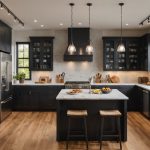Innovative Lighting Ideas for Your Kitchen Makeover
Embarking on a kitchen transformation involves mindful choices, especially regarding lighting. The key to achieving both functionality and aesthetics lies in the artful layering of light, combining various sources to create an inviting and efficient space.
Start with innovative kitchen lighting solutions such as pendant lights. These not only provide focused task lighting over your island or dining areas but also add a design focal point. Complementing pendants with under-cabinet lighting ensures that your countertops remain well-lit, enhancing both safety and functionality during meal preparation.
Topic to read : Elevate your cooking space: unlocking energy savings in smart kitchen designs during high demand hours
To maximise the charm of natural light, consider creative lighting ideas like using light-coloured surfaces to reflect daylight. Large windows or well-placed mirrors can significantly boost daytime brightness, making the kitchen feel larger and more welcoming. Also, installing sheer curtains or blinds that can be easily adjusted allows you to control the influx of sunlight throughout the day.
Layered lighting effectively transforms your kitchen, providing versatile solutions for different activities and times of the day. It harmoniously blends natural and artificial light sources, turning a routine cooking area into a hub of creativity and comfort. Embrace these creative lighting ideas to illuminate your kitchen makeover journey with style and practicality.
Additional reading : Designing a dynamic kitchen: tailoring culinary spaces for carnivores and herbivores alike
Energy-Efficient Lighting Options
In today’s world, energy-saving lighting is key to reducing electricity consumption and environmental impact. One prominent option is LED kitchen lights. LEDs are the frontrunners in energy efficiency, using up to 75% less energy than traditional incandescent bulbs. This is primarily due to LEDs converting a higher percentage of electricity into light rather than heat.
The benefits don’t stop at bulb types. Dimmers and smart lighting systems also play a significant role in energy conservation. Dimmers allow you to adjust the brightness of your lights, reducing energy use over time. Similarly, smart lighting systems give you control over when and where lights are used, further boosting efficiency.
Selecting the right wattage and lumens is critical for optimal performance. Lumens measure the amount of visible light emitted, while wattage measures energy consumption. Ideally, you should choose lights with lower wattage but higher lumens to maximise light output while minimising energy use. For instance, a 10-watt LED can provide the same brightness as a 60-watt incandescent bulb.
In summary, by opting for energy-efficient options, you can enjoy adequate lighting while contributing to energy conservation and cost savings in the long term.
Design Trends in Kitchen Lighting
The world of kitchen lighting is evolving, balancing between minimalist and statement lighting designs. In today’s design trends, minimalist fixtures focus on sleek lines and simple forms, allowing other design elements in the kitchen to shine. On the other end of the spectrum, statement lighting stands as an attention-grabbing centerpiece, often featuring bold shapes and intricate details.
Incorporating vintage or retro styles into the kitchen provides a unique and eclectic touch that can complement various aesthetics. Imagine the charm of an old-world chandelier amid modern cabinetry, or retro pendant lights contrasting with contemporary appliances. These stylistic choices resonate with many homeowners looking for a blend of nostalgia and modernity in their kitchens.
Choosing the right color temperature for your kitchen lights is crucial. Warm lights create a cozy, inviting atmosphere, ideal for areas focused on relaxation and gathering. Conversely, cool lights work best in task-oriented spaces where visibility and clarity are paramount. A balanced combination of both warm and cool tones can enhance both functionality and ambiance, crafting a well-rounded lighting strategy.
Product Recommendations for Transformative Lighting
Navigating the realm of best kitchen lighting products can feel overwhelming with the many options available, but understanding product differences simplifies decision-making.
Review of Popular Kitchen Lighting Brands
Popular brands like Philips, GE, and Kichler often top product reviews due to their innovation and durability in lighting fixtures. Philips, renowned for smart lighting solutions, integrates seamlessly with smart home ecosystems, offering energy-efficient LEDs that adapt to ambiance needs. GE’s focus on classic aesthetics and robust technology ensures that their fixtures not only illuminate but enhance kitchen decor. Kichler, celebrated for distinctive designs, impresses homeowners looking for unique fixtures with flair.
Price Points and Value for Money
The price range for kitchen lighting varies significantly based on style, functionality, and brand reputation. Philips’ smart bulbs are premium-priced, yet provide excellent longevity and versatility. Meanwhile, GE offers competitive pricing without compromising on quality. Kichler tends to be on the higher end, but their artisanal designs justify the investment for many.
Where to Buy
To acquire these lighting fixtures effortlessly, retailers like Amazon, Home Depot, and Wayfair provide extensive selections. These platforms offer customer reviews to guide purchasing decisions, ensuring you get value without sacrificing quality. Starting your search on these sites often yields the best deals and availability.
Installation Tips for Optimal Lighting
Installing kitchen lighting involves careful planning and execution to ensure functionality and aesthetics. Whether you’re considering a DIY lighting approach or professional installation, understanding the steps for different lighting types is crucial.
When contemplating DIY, start with a well-thought-out plan. Identify where each light fixture will go, considering task and ambient lighting needs. Before any installation, ensure you have the correct tools, such as a voltage tester, wire stripper, and drill. Follow these steps for basic installations:
- Turn off the power at the circuit breaker to remain safe.
- Mount the fixture according to the manufacturer’s instructions.
- Connect the fixture’s wires to your home’s wiring. Usually, this involves matching colours, such as black to black and white to white.
- Secure the fixture and restore power to test the installation.
Despite a comprehensive guide, some installations demand professional expertise. For example, when dealing with track lighting or recessed lights, hire a professional. They can manage intricacies and ensure code compliance.
Common mistakes during kitchen lighting installation include overloading circuits and improper fixture positioning. Overburdened circuits overheated kitchen fixtures, leading to hazards, while poorly placed lighting can cause unwanted shadows, rendering the kitchen inefficient. Avoid these errors to achieve a well-lit kitchen space.
Before-and-After Transformations and Visuals
Before diving into your kitchen makeover, it’s inspiring to explore kitchen makeover examples that showcase stunning transformations, particularly through lighting transformations. Effective lighting can elevate a kitchen from drab to fab, enhancing both aesthetics and functionality.
Case studies of successful kitchen lighting makeovers often illustrate how strategic changes can have a significant visual impact. For instance, replacing outdated fixtures with modern pendant lights can create a focal point, while under-cabinet lighting adds subtle yet effective illumination. These makeovers demonstrate that even minor alterations can dramatically alter the kitchen’s atmosphere.
Visual inspiration plays a pivotal role in planning your lighting transformation. High-quality photographs capture the essence of the change, showcasing the contrast between the ‘before’ and ‘after’ stages. These visuals help you envision the potential outcome and guide your decisions.
As you embark on your journey, consider documenting the process to create your own compelling transformation story. Capture images at different stages, and experiment with various lighting combinations. Not only does this provide personal satisfaction, but it also serves as a valuable reference for future projects, offering insights into what strategies work best for your space.











